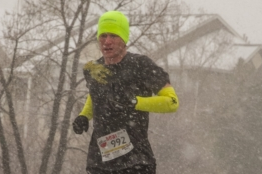After winning the last-ever Jackalope 5K in Laramie, Wyoming a little over a year ago, held on a beautiful course and on a beautiful day, I figured it had been a good final race at that distance. It’s the second-most difficult event to compete in, just behind the grueling 800M. You have to put the pedal to the metal for three point one miles and it’s excruciating. Yet, a couple of weeks ago I found myself signing up for another one on July 4th.
Part of this inability to sever ties with the 5K may be that it was my formative race distance many years ago. There’s also an adrenaline factor with it. It rewards the well-prepared runner who carries out a good race plan and there’s no room for error.
The course for the one I did on July 4th is less than ideal and I knew that ahead of time. It’s two miles down and one up. When you have courses where there are long climbs and descents as opposed to occasional hills, it’s much easier to have the downhill on the latter part of the course. When the bulk of the second half is mostly uphill, it takes careful planning. This is unpleasant and yet it also contributes to the thrill factor. So why exactly am I doing this to myself? The thrill factor is hard to beat, and there’s something to that.
With no significant speed training or high mileage while leading up to this race, I penciled in a modest goal. My recent 5K times have been in the mid to high 19s so if I could keep it to somewhere between 20:00 to 20:45, I was fine with that. I planned a pace of 6:30 for the first two miles, leaving enough gas in the tank to cover the last uphill mile in 6:45-6:50.
When the race started, the lead runners shot off the line like a rocket and I crossed the one-mile in 6:00. (Per last week’s post, I’m going with the excuse that pacing is difficult, even when it’s well-planned.) Somehow, I felt fine and the downhill profile helped with that, but while 6:00 all the way through would yield an 18:40, that wasn’t happening on this one. I backed off a little, knowing that mile three was looming. Consequently, I felt relatively strong the whole way. There was a group of three of us still together at mile two and among them I was third. Fortunately, my surge over the last half-mile was strong enough to get past one of them which, given how low on gas I was, felt good. I finished sixth overall and first in my age group with a time of 20:08.
It was the best I’d felt in any 5K in years. Going in with modest expectations may have helped, and “best I’d felt” is relative. Compared to how I feel in other races, it was still a grind. And, I will probably find myself in another one in the near future. It drove home the realization that I can refuse to sign up for 5Ks, yet the 5K is just too strongly ingrained in my running DNA for me to actually retire from it.
Running food review of the week: (note–gels, bars, chews, and other items affect everyone differently. Try them on a short run before using them for a key training run or race): Run Gum Spearmint: This is highly-caffeinated gum and one tablet equates to one cup of coffee, which is around 95 mg. Most running foods with caffeine have 25-35 mg with the exception of a couple of the espresso flavors that have more. The texture didn’t start out like traditional gum but a few moments in, it felt and tasted like any other piece of spearmint gum. I did feel a nice boost of energy but going forward I would use it to help supplement non-caffeinated running food. For example, if I were on a longer run and wasn’t sure if I wanted a caffeine boost, I would carry some Clif Bloks or a waffle and, if I needed caffeine, would use one of these right after I finished the other food.

Running anecdotes, running food reviews, some race coverage, and more